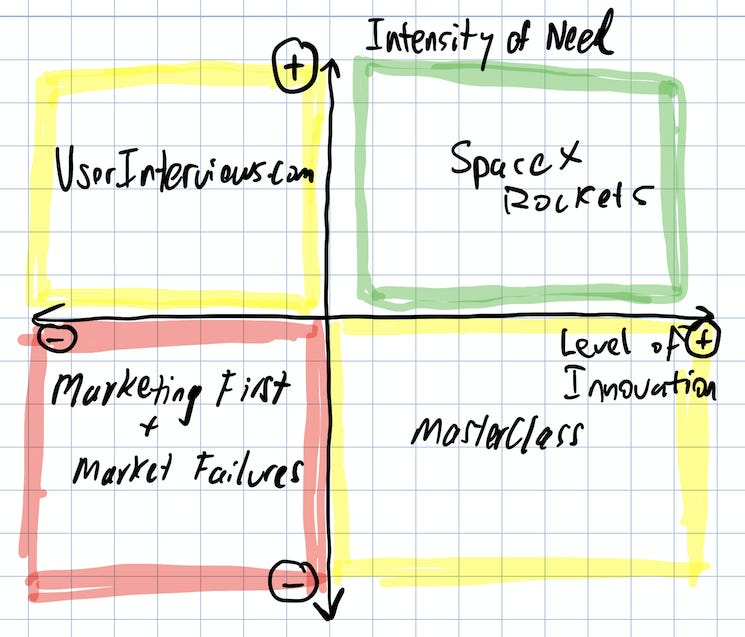Marketing Isn’t For Everyone
Simple but powerful post today, and the bottomline is that marketing isn’t for every business. Increasingly I find that marketing is…
Marketing isn’t for every business. Increasingly I find that marketing is necessary inversely proportional to the amount of innovation and differentiated value being generated. Let’s consider some extreme examples:
SpaceX was the first company to make a reusable rocket capable of delivering a payload into outer space. For the part of the market that needs this capability (NASA, satellite manufacturers, space tourists etc), they have been searching for it for decades, and its existence earns its own press and attention, so the majority of its potential users are aware it exists. There is little to no risk that ignoring marketing will undermine the business.
On the opposite end of the spectrum is something like a new take on a timer app, for example https://e.ggtimer.com/. I love this app; it’s simple, creative, and fixes some key usability issues, but ultimately it’s just a timer with some usability enhancements. There are thousands of others. It does not get into my brain simply because it exists.
Let’s take this a step further. Another vector to consider is the intensity of the customer need. The more intense the customer pain, the less marketing is required to gain attention and differentiate. MasterClass, for example, is a great product offering. Online classes are not new or novel, but the company innovates by offering classes in non-traditionally academic disciplines (ex: making a techno dance song or starting a business) and only from the most famous and accomplished personalities who normally are not teachers, so there is real innovation. However, very few of us have a burning need to learn how Hans Zimmer creates the musical score for a film, so marketing is fairly important to get the message out, get consumers excited, and make a sale.
A similar level of marketing is needed for products solving an intense customer pain but without too much innovation. UserInterviews.com is an example and so is ProductBoard. For product managers looking for customer signal, UserInterviews.com makes it easy to find those users, set up time with them, and pay them, and for ProductBoard, the challenge of managing signal from customers on new product features is solved. Both deliver solutions to powerful problems for specific types of customers, but neither does so in a way that would be particularly hard to replicate. ProductBoard is functionally a CRUD app for product signal with some basic connectors to 3rd party apps like Zendesk and some dashboards of that same data, and UserInterviews.com is an amalgamation of existing tools with a pre-existing population of participants. They are value-able businesses no doubt, but ones that must engage in a degree of marketing to be noticed and grow.
In the final red quadrant we have our market failures and our marketing-first firms. The market failures exist because if you haven’t solved a serious customer pain AND if you have not innovated much, there’s a good chance that the business cannot sustain itself. That said, especially in fashion and beauty, I see evidence of exceptions to this rule in times when a marketing-first approach is able to convince would-be buyers that the slight benefit they receive is worth their money or time. Examples include companies that, for example, allow you to get a subscription to replenish razor blades like Dollar Shave Club. Often the blades are a commodity and so is the shipping, and the inconvenience of not having to buy your own blades on Amazon or at a drugstore is extremely small. Another example is the set of companies that are re-branding women’s fragrances, lotions, or toiletries for men, in some cases with nearly identical formulations but with novel packaging that speaks differently to the genders, for example Dude Wipes. These firms must rely on a heavy marketing-first approach to build initial traction and grow. The sale relies on how the consumer feels more than a specific benefit.
It should be noted that the level of competition is related to both factors under consideration. Markets that solve small or intense pains with low innovation barriers tend to be crowded, exacerbating the need to clearly differentiate and market.
In conclusion, this is not a critique of any one quadrant — great businesses exist in all four. The only question is how first-class will marketing need to be in that initial growth.



